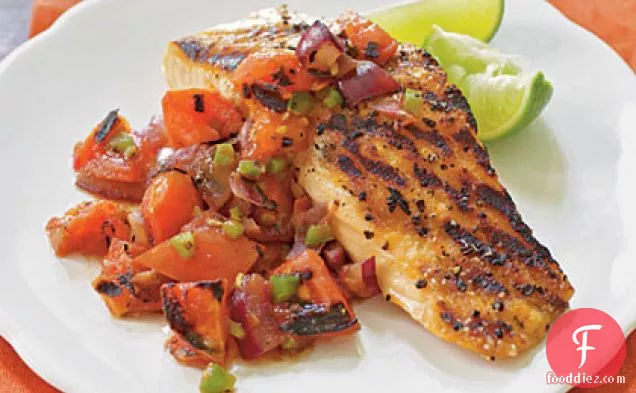Grilled Salmon with Smoky Tomato Salsa

Grilled Salmon with Smoky Tomato Salsa might be just the Mexican recipe you are searching for. Watching your figure? This gluten free, dairy free, and primal recipe has 270 calories, 35g of protein, and 11g of fat per serving. This recipe covers 28% of your daily requirements of vitamins and minerals. This recipe serves 4. It will be a hit at your The Fourth Of July event. A mixture of jalapeño pepper, onion, plum tomatoes, and a handful of other ingredients are all it takes to make this recipe so tasty.
Instructions
2
Sprinkle fillets with 1/4 teaspoon salt and 1/4 teaspoon black pepper.
Ingredients you will need![Black Pepper]() Black Pepper
Black Pepper![Salt]() Salt
Salt
3
Place on grill rack coated with cooking spray, and grill for 4 minutes on each side or until desired degree of doneness.
Ingredients you will need![Cooking Spray]() Cooking Spray
Cooking Spray
Equipment you will use![Grill]() Grill
Grill
4
Place tomatoes, onion, and jalapeo on grill rack coated with cooking spray; grill tomatoes, cut side down, 6 minutes. Turn; grill for 1 minute. Grill onion and jalapeo for 6 minutes on each side or until lightly browned.
Ingredients you will need![Cooking Spray]() Cooking Spray
Cooking Spray![Tomato]() Tomato
Tomato![Onion]() Onion
Onion
Equipment you will use![Grill]() Grill
Grill
5
Remove from grill, and cool slightly. Coarsely chop tomatoes and onion; finely chop jalapeo.
Ingredients you will need![Tomato]() Tomato
Tomato![Onion]() Onion
Onion
Equipment you will use![Grill]() Grill
Grill
Equipment
Ingredients
Recommended wine: Chardonnay, Pinot Noir, Sauvignon Blanc
Salmon works really well with Chardonnay, Pinot Noir, and Sauvignon Blanc. To decide on white or red, you should consider your seasoning and sauces. Chardonnay is a great friend to buttery, creamy dishes, while sauvignon blanc can complement herb or citrus-centric dishes. A light-bodied, low-tannin red such as the pinot noir goes great with broiled or grilled salmon. The Tyler Winery Santa Barbara County Chardonnay with a 4.1 out of 5 star rating seems like a good match. It costs about 30 dollars per bottle.

Tyler Winery Santa Barbara County Chardonnay
2015 brought the earliest vintage of the decade so far. After the large 2013 and 2014 vintages and the continued drought, the vines put forth a fraction of the fruit than the previous two years. They were down approximately 30% overall but the result was exceptional quality and deep, powerful wines with great acidity. Citrus, anise, saline, and energetic.DifficultyMedium
Ready In45 m.
Servings4
Health Score100
CuisinesMexican
Occasions4th Of JulySummer
Magazine

Your Inner Chef with Taylor Swift's Top 3 Recipes from Her Beloved NYC Hangout

20 Mouthwatering Recipes You Need to Try Today!

Master the Art of Making Perfect Pancakes with This Foolproof Recipe

The Science Behind Red Wine: Its Surprising Health Benefits and Potential Risks

12 Wine Cocktails for a Sophisticated Twist

Sip, Swirl, and Celebrate: Toasting to National Wine Day on May 25th

National Drink Wine Day on February 18

Celebrating Souffle Day with Delectable Delights

Indulge in the Delightful Flavor of Oyster Soup on Its Special Day!

Celebrating World Nutella Day

Your Inner Chef with Taylor Swift's Top 3 Recipes from Her Beloved NYC Hangout

20 Mouthwatering Recipes You Need to Try Today!

12 Wine Cocktails for a Sophisticated Twist

Sip, Swirl, and Celebrate: Toasting to National Wine Day on May 25th

National Drink Wine Day on February 18

Indulge in the Delightful Flavor of Oyster Soup on Its Special Day!

These Super Recipes for Your Football Party!

The Secrets Behind 3 Classic Comfort Food Recipes

Recipes to Spice Up Your February Menu
















